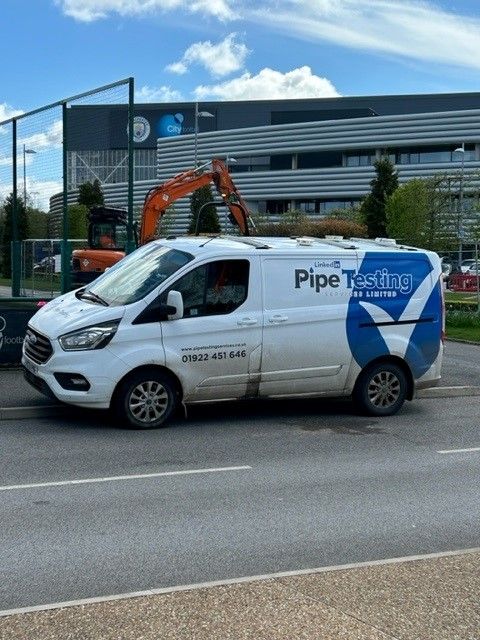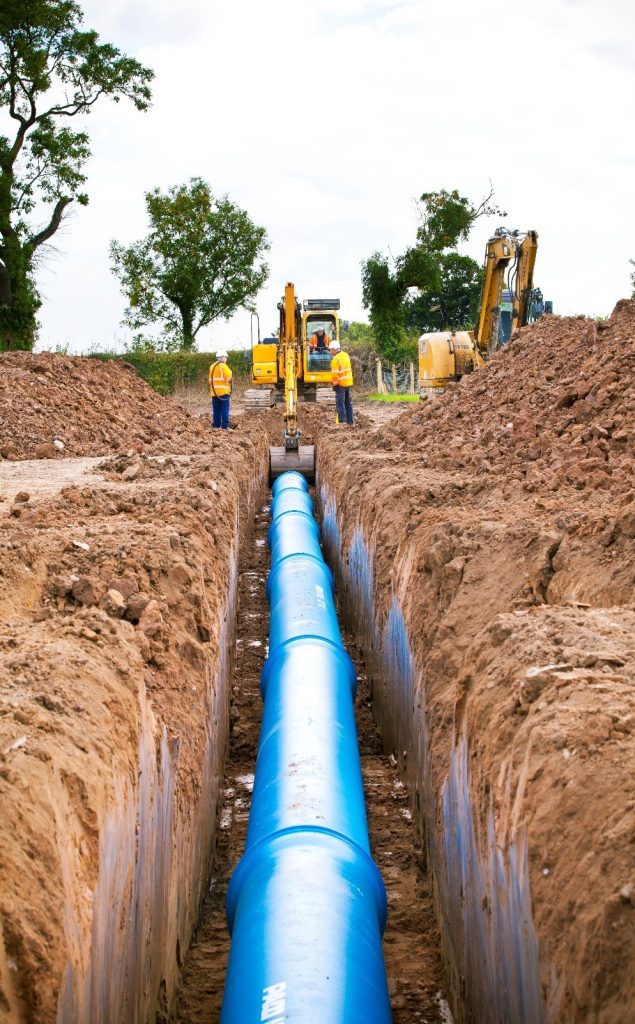Hydrostatic Pressure Testing of Rising Water Mains
Rising water mains are critical components in water distribution networks across the UK. They transport fresh water from treatment plants or reservoirs to storage tanks and distribution systems, ensuring a reliable supply to households and businesses.
However, these pressurised pipelines are subject to various stresses, making pressure testing an essential process to ensure their structural integrity, prevent leaks, and comply with stringent regulations.
Hydrostatic pressure testing is the preferred method for evaluating rising water mains in the UK. This technique involves filling the isolated pipe section with water and subjecting it to controlled, high pressures, mimicking real-world operating conditions. By monitoring the system’s performance under these stresses, any weaknesses or defects can be identified and addressed before commissioning the rising main.
At Pipe Testing Services (PTS), we carry out hydrostatic and rising mains pressure testing services regularly for clients nationwide. If you’re looking for a cost-effective testing solution for water infrastructure and pipelines, don’t hesitate to get in touch.
In need of services – take a look here. Alternatively, take a look at our dedicated site for Hydrostatic pressure testing.
Testing Procedure
Before hydrostatic pressure testing can commence, thorough preparation is crucial. First, the section of the rising main to be tested is isolated using temporary end closures and valves. This step ensures that the test pressure is contained within the designated area, minimising potential impacts on the surrounding environment.
Learn more here about – Sectional vs Complete System Hydrostatic Testing – and our recent blog; Valve to Valve Hydrostatic Testing Procedure to get an understanding of our different methods, and processes, depending on the work required.
Next, the isolated section undergoes swabbing and flushing processes to remove any debris, residual materials, or air pockets that could compromise the test results. Proper venting is also performed to ensure the complete removal of trapped air, allowing the test medium (water) to fill the rising main entirely.

Hydrostatic Testing Steps
- Filling and Venting: The isolated rising main section is filled with clean water, the test medium. During this process, additional venting is performed to eliminate any remaining air pockets, ensuring a homogeneous water column within the pipe.
- Pressurization: Using high-pressure pumps or compressors, the water within the rising main is gradually pressurised to the specified test pressure. Calibrated pressure gauges and data loggers continuously monitor the system, ensuring the target pressure is achieved and maintained within acceptable tolerances.
- Pressure Hold: Once the desired test pressure is reached, it is held for a predetermined period, typically ranging from 2 to 8 hours, depending on the specific requirements of the project and the applicable regulations. During this hold period, the pressure gauges are closely monitored, and visual inspections are conducted to detect any leaks or pressure drops.
- Depressurization and Draining: After successfully completing the pressure hold period, the system is safely depressurised following established protocols. The test medium (water) is then drained from the rising main, preparing it for the next steps, such as dewatering, dechlorination (if required), and eventual commissioning.
Testing Requirements
Hydrostatic pressure testing of rising water mains in the UK is governed by several regulations and standards, including:
- Water Supply (Water Quality) Regulations 2000: These regulations set out requirements for the quality of water supplied for domestic and food production purposes, including provisions for the testing and maintenance of water distribution systems.
- Water Industry Act 1991: This act establishes the legal framework for the water industry in England and Wales, including provisions for the construction, maintenance, and operation of water mains and distribution systems.
- British Standards (BS): Various British Standards, such as BS EN 805 and BS 6700, provide guidance on the design, installation, and testing of water supply systems, including specific requirements for hydrostatic pressure testing of water mains.
The maximum allowable test pressure for polyethylene (PE) rising mains is calculated based on the guidelines outlined in the Water Industry Specification (WIS) 4-01-03. This calculation considers factors such as the pipe material, design pressure, and safety factors to ensure the integrity of the system during testing.
Testing Equipment for Hydrostatic Pressure Testing of Rising Water Mains
Hydrostatic pressure testing of rising water mains requires specialised equipment to ensure accurate and reliable results. Some essential equipment used in this process includes:
High-pressure Pumps & Compressors
The pressures involved in hydrostatic testing can be extremely high, posing risks of equipment failure, piping ruptures, and injuries. Strict adherence to safety protocols, proper use of personal protective equipment (PPE), and maintaining safe distances are essential.
Calibrated Pressure Gauges & Data Loggers
Accurate pressure measurement is crucial during testing. Calibrated gauges and data loggers continuously monitor and record the pressure levels throughout the process.
Temporary Piping, Valves, Fittings, & End Closures
These components are used to isolate the test section, connect testing equipment, and facilitate the filling, pressurization, and draining processes.
Air Vents & Drains
Proper venting and draining are essential for successful hydrostatic testing. Air vents and drains are used to remove trapped air pockets and facilitate the flow of water during filling and draining.
Swabbing & Flushing Equipment
Before testing, the rising main section must be thoroughly cleaned and flushed. Swabbing and flushing equipment is used to remove debris, residual materials, and contaminants that could impact the test results.
Safety Considerations
Safety is paramount when conducting hydrostatic pressure testing of rising water mains. These tests involve working with high pressures, which can pose significant risks if proper precautions are not taken. Potential hazards include water hammer, pipe failure, environmental concerns, and personnel safety.
To mitigate these risks, comprehensive safety protocols, risk assessments, and emergency response plans must be in place, in accordance with UK regulations and guidelines, such as those provided by the Health and Safety Executive (HSE). Appropriate personal protective equipment (PPE) should be worn by all personnel involved in the testing process, and safe working distances must be maintained.
Additionally, environmental concerns should be addressed, such as the proper containment, treatment, and disposal of any water discharged during testing.
Post-Testing Activities
Once the hydrostatic pressure testing is successfully completed, and no leaks or defects are identified, the rising water main can proceed to the next stages of commissioning. This may involve dewatering the system, dechlorination (if required), and final preparations for putting the rising main into service.
However, if leaks or defects are discovered during testing, prompt action must be taken to address these issues. Depending on the severity and location of the problem, repair or replacement of the affected sections may be necessary before proceeding with commissioning.
Testing Services and Certification
At Pipe Testing Services (PTS), we offer professional hydrostatic pressure testing services for rising water mains across the UK. Our team of experienced technicians and engineers is equipped with state-of-the-art testing equipment and follows strict quality control protocols to ensure accurate and reliable results.
Our testing services comply with all relevant UK standards and regulations, including the Water Supply (Water Quality) Regulations 2000, Water Industry Act 1991, and British Standards. Additionally, our team includes EUSR approved engineers and CHAS card holders, ensuring the highest levels of competency and safety.
Frequently Asked Questions (FAQs)
How often should rising water mains undergo hydrostatic pressure testing?
The frequency of hydrostatic pressure testing for rising water mains depends on various factors, including the age of the pipeline, the material used, the operating conditions, and local regulations. Generally, it is recommended to conduct pressure testing during the initial installation and commissioning, as well as periodically throughout the lifecycle of the rising main, especially after any repairs or modifications.
What is the maximum allowable test pressure for PE rising water mains?
The maximum allowable test pressure for polyethylene (PE) rising water mains is calculated based on the guidelines outlined in the Water Industry Specification (WIS) 4-01-03. This calculation considers factors such as the pipe material, design pressure, and safety factors to ensure the integrity of the system during testing.
Can hydrostatic pressure testing be performed on existing, operational rising water mains?
Yes, hydrostatic pressure testing can be performed on existing and operational rising water mains. However, proper isolation and preparation procedures must be followed to ensure the safety of the testing process and minimise disruptions to the water supply.
How long does a typical hydrostatic pressure test take for rising water mains?
The duration of a hydrostatic pressure test for rising water mains can vary depending on factors such as the length of the pipeline, the testing requirements, and the specific procedures followed. Generally, the pressure hold period can range from 2 to 8 hours, but the entire testing process, including preparation and post-testing activities, may take several days or longer.
What are the potential consequences of failing a hydrostatic pressure test for rising water mains?
Failing a hydrostatic pressure test for rising water mains can indicate the presence of leaks, defects, or weaknesses in the pipeline system. This can lead to water loss, potential contamination, and structural failures if not addressed promptly. Depending on the severity of the issue, repairs, replacements, or additional testing may be required before the rising main can be commissioned or put back into service.
Is it necessary to use a specific type of water (treated, dechlorinated, etc.) as the test medium for hydrostatic pressure testing of rising water mains?
The type of water used as the test medium for hydrostatic pressure testing of rising water mains may be specified by the relevant regulations or project requirements. In general, clean water without excessive contaminants or chemicals is preferred. However, dechlorinated or treated water may be required in some cases to prevent potential corrosion or environmental concerns during the testing process and subsequent discharge.
Get in Contact with PTS for Expert Hydrostatic Pressure Testing Services
At Pipe Testing Services (PTS), we specialise in providing comprehensive hydrostatic pressure testing services for rising water mains that comply with the highest industry standards and regulations across the UK.
Our experienced team, combined with state-of-the-art testing equipment, ensures the integrity of your water distribution systems, mitigating potential risks to the environment, public safety, and your valuable assets. We understand the critical importance of properly testing rising water mains to prevent leaks, water loss, and potential contamination issues.
Whether you require hydrostatic pressure testing during the initial installation of new rising mains or periodic testing of existing systems, we have the expertise to meet your specific project requirements. Our services encompass all aspects of the testing process, including preparation, pressurization, monitoring, documentation, and post-testing activities.
In addition to rising water main testing, we offer a range of related services, such as pipeline flushing, dewatering, and commissioning support, ensuring a comprehensive solution for your water infrastructure needs.
If you have any further questions or need assistance with hydrostatic pressure testing of rising water mains, complete system testing, or any related services, please don’t hesitate to contact our experts at PTS.
Phone – 01922 451646
Email – enquiries@pipetestingservices.co.uk
Address – Unit 27 Birchbrook Industrial Estate, Shenstone, Lichfield, Staffs, WS14 0DJ
At PTS, we are committed to delivering reliable, safe, and compliant testing solutions that safeguard the integrity of your water distribution systems and contribute to a sustainable water supply for communities across the UK.


